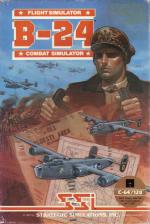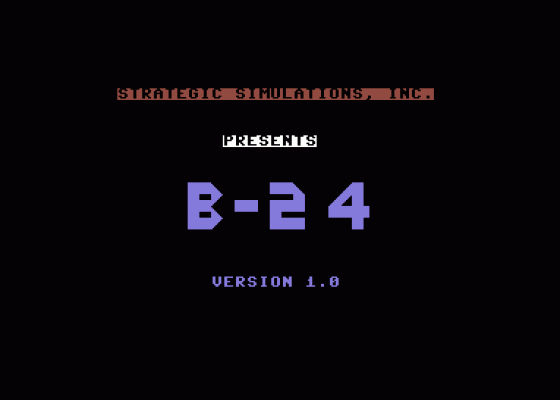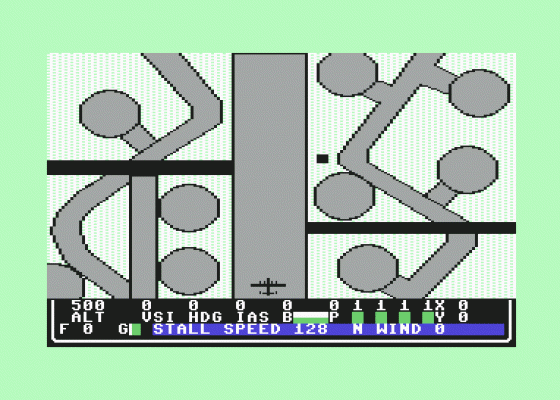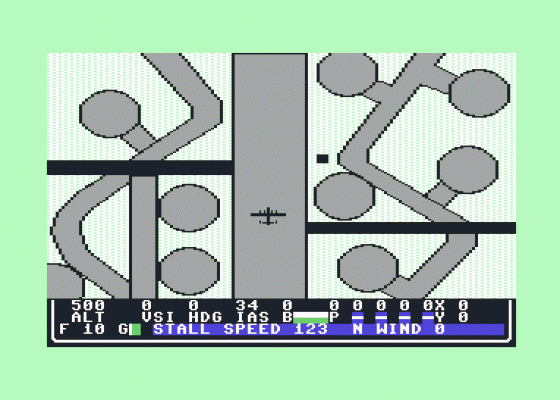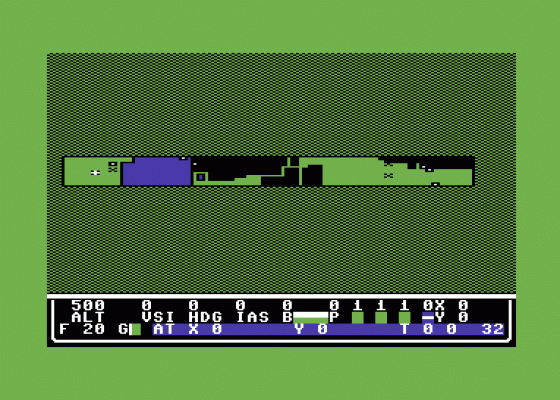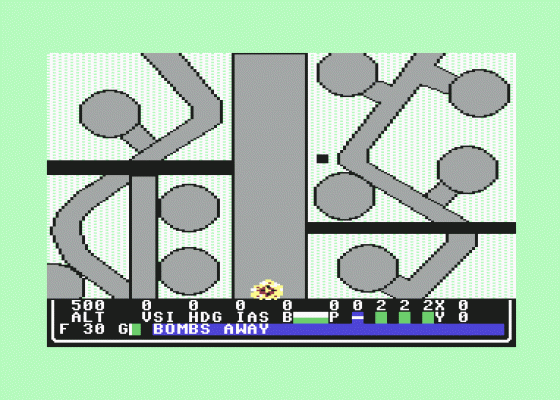
Zzap
 1st October 1987
1st October 1987
Categories: Review: Software
Publisher: Strategic Simulations Inc
Machine: Commodore 64/128
Published in Zzap #30
Zzap Sizzler
B-24 Flight Simulator
Machine simulations are, when you think about it, at one extreme of the wargaming scale. Some games allow you to move armies across continents over a period of months, some ask you to direct divisions in a single battle, and a few let you position individual men in combat. Simulation games however put you directly behind the gunsight, and let you press the buttons - they represent a cross between the action of arcade gaming and the ideas of strategy gaming.
B-24 Flight Simulator and Combat Simulator, as it's more or less called (hardly a memorable title I trust you'll agree) puts itself firmly in the wargaming camp. A more appropriate title would be something like 'Mission Over Ploesti', although the operation of the gameplay involves flying a B-24 bomber at a level of some mechanical detail, the focus is firmly fixed on the object of the flight and most of the excellent documentation concentrates on the target rather than the machine. This is an unusual emphasis for a flight simulation, but it turns out to be what makes B-24 more playable and absorbing than flight simulators usually are. It achieves this by cutting out what is normally considered to be an essential element in this sub-genre, the computer-generated impression of flight itself.
During the Second World War, the two of Ploesti in Rumania provided Hitler with most of his oil for the Axis War effort. It was reckoned that if the numerous oil refineries around Ploesti could be bombed into non-productive oblivion then Hitler's war machine would creak to a rusty stop. Accordingly, both the British and American air-forces launched a series of bombing raids on Ploesti, which was once known as the 'white town of black gold'. After 339 bombers had been shot down over there during the 25 attacks, it was called 'the bombers' graveyard' by Allied air crews. The campaign game allows the player to fly the nineteen missions attempted by the (presumably American) 460th Bomb Group, which was based at Spinazolla near the East coast of Italy. Essentially the player is fighting history; the aim is to get the production of oil refineries down lower than the historical figure after the B-24s had finished their attack. Doing better than the original crews means that you will shorten the Second World War.
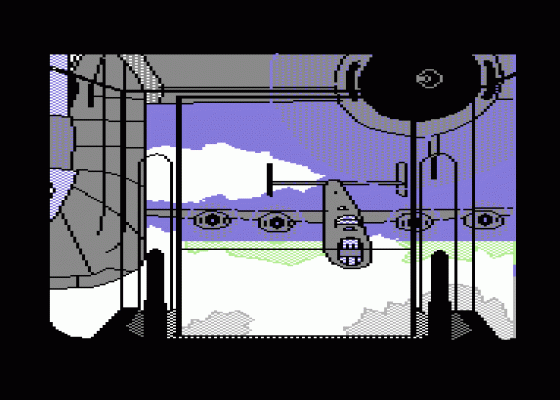
Thoughtfully, the game also provides the player with an easy introductory mission; bombing another town, Mostar, which is right on the west coast of Yugoslavia, and is therefore easy to reach from Spinazolla. There is also a particularly difficult individual mission to Bucharest, which is so far from base that it requires efficient flying to make it there and back without carrying so much fuel that there's no room for a sufficient number of bombs.
The screen display does not show the interior of a cockpit, as one would usually expect of a flight simulator. Instead, the B-24 is viewed from above as an extremely basic aeroplane shape, flying over a pleasantly drawn and detailed landscape. The first 'screen' shows the landing strip, viewed at close range, but as soon as the plane lifts off the player finds himself looking down at the ten-mile square surrounding the airbase from an indeterminate height.
Although, of course, the aeroplane can move up and down tens of thousands of feet, there is no visual representation of three-dimensional movement... and therefore no sensation of flying at all. And although the stick drawing aeroplane does point itself in the right general direction when the player changes its beating, it does so very inexactly. Information about the plane's precise location is gained from the numbers on the instrument panel, which yet again makes no attempt at visual realism. There are no blurred dials or unhelpful lights in this flight simulator. All instruments give their readings in neatly arranged numerical form, and the main difficulty in learning how to fly the plane is remembering which of these numbers are important.

All this may be seen as a drawback for those looking for a flight simulator - but for those looking for a game, I think the compromises are worth it for the sake of clarity. The actual mechanism of the B-24 is authentically simulated, and the plane reacts noticeably to carrying extra weight, to wind speeds, and to limping along with three of its engines out and one of its wings on fire.
The relevant parts of Italy, Yugoslavia and Rumania are divided into ten-by-ten mile squares, filled either with mountains, land, sea or hill. These terrain types are important insofar as it's best to fly at a sufficient altitude to avoid crashing into them. One screenful represents one square on the glossy card map provided, so if your instruments are taken out in combat it's possible to navigate 'by hand'. Normally, pressing a key will bring up a navigator's report, telling you precisely where you are, with co-ordinate's exact to two decimal places.
When playing the campaign game, the player has to choose a mission to any one of the twelve refineries situated around Ploesti. Daily production figures are displayed on the campaign screen, and as they are taken out their production will drop. Having chosen the target, the aim is then to get to Ploesti - balancing the amount of fuel taken with a sufficient number of bombs.
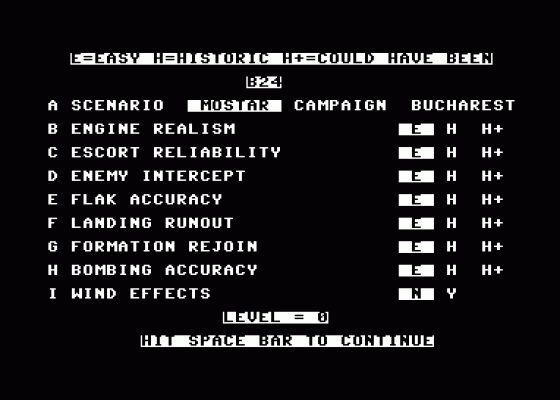
Before you can head off Ploesti-wards, you have to assemble your squadron. This involves circling above the airfield at the right height, keeping up the correct speed; if any bombers drop out, that will be one less for the mission. There's also a fighter escort to pick up at a specified location, to protect the bombers from 'bogeys' on the journey out. Near the target, if you get there in time, you pick up a bombing escort. To bomb successfully, you have to be exactly on the right course - something which requires a lot of fine manoeuvring. A strong wind can make it very difficult to attain and maintain any course at all. Bomb sights, which come into operation once you open the bomb doors, enable you to fine-tune your position and send the bombs away almost exactly over the target.
It's concentrating on the mission that gives this game atmosphere, and the superb documentation - there's a separate book full of information about Ploesti, including an extract from a B-24 pilot's autobiography - enhances the sense of involvement which is invited by the straightforward gameplay. A minor complaint is the irritating drone of the plane's engines which keeps going throughout the flight, though when you stall or run out of fuel, the silence that ensues is suitably ominous - and you can always turn it down. The difficulty level is adjusted by altering a set of parameters such as engine reliability, and whether you want any weather or not, so the challenge is extensive.
Maybe it would get boring eventually flying back and forth to Ploesti if you really played the game to death, but you have the option of bombing Bucharest for target practice, and the fact is that this flight simulator, unlike many, encourages persistance and playing until the early hours.
Verdict
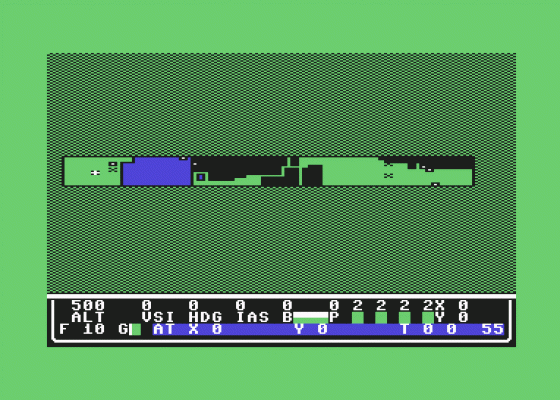
Presentation 75%
Quite a 'solid' appearance and thankfully no disk access pauses, but the program seems sluggish to respond to the joystick and keypresses.
Graphics 70%
The landscape is pleasant, with aerially-visible features like roads convincingly marked - but the plane itself has about three frames of animation.
Rules 95%
The documentation is a major feature, containing a large amount of information about Ploesti and the missions that were sent out over it.

Authenticity 93%
Despite the lack of 'real' flight simulation graphics, it's easy to get absorbed in the historical atmosphere. Also, the plane's dynamic reactions to flight conditions are very credible.
Playability 89%
Once you've got the hang of it, it's difficult to stop.
Overall 90%
A convincing and absorbing game, which may well appeal to those who don't usually like conventional flight simulators.
Other Reviews Of B-24 Flight Simulator For The Commodore 64/128
B24 (SSI/US Gold)
A review by Tony Hetherington (Commodore User)

